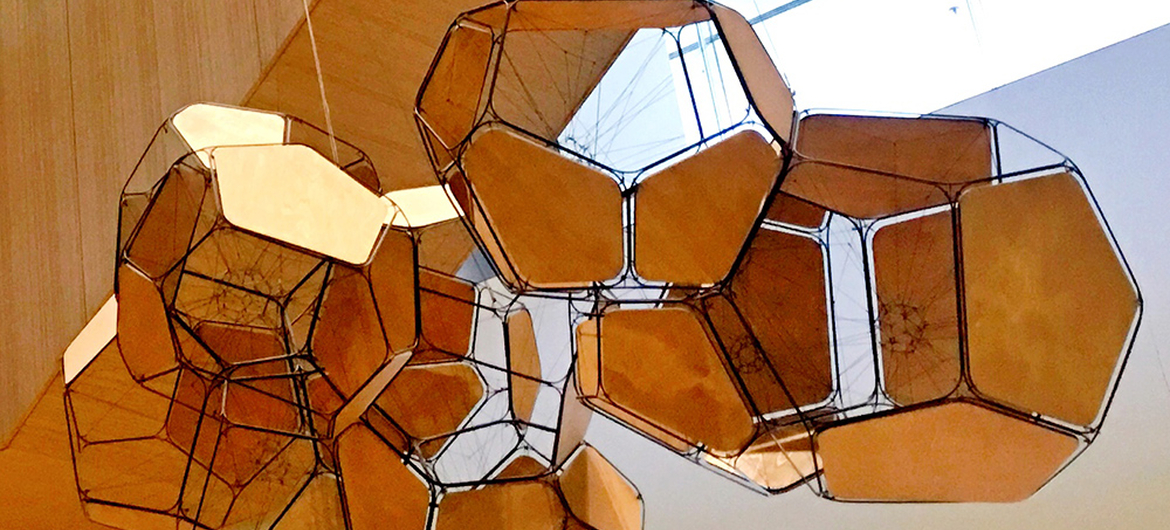Title: 42 Drab / M+M, 5 cloud modules
Year: 2015
Material/Technique: Plywood, polyester rope, fishing line, steel, glue
Dimensions: Five modules of variable dimensions
Inspired by spider webs and bubbles, Saraceno employs tridimensional structures to better understand how unique building blocks create distinct forms. He places spiders in cubic frames and leaves them to spin webs, rotating the cubes at various intervals to introduce elements of freedom; the process results in disoriented yet structurally stable webs. Translating the complex geometries culled from his spider studies into habitable structures, Saraceno has built spaces that merge art, architecture, and science. Saraceno’s oeuvre could be seen as an ongoing research, informed by the worlds of art and natural sciences, on proposing and exploring new, sustainable ways of inhabiting and sensing our environment.
Positioned in the stairwell atrium of Novartis’ laboratory building these architectonic modules appear to float down like cellular structures twirling under a scientist’s microscope.
The Artist
Tomás Saraceno (Tucumán 1973-) currently lives and works in Berlin, Germany. He studied architecture and art in Buenos Aires, Frankfurt am Main, and Venice. He established his studio in Frankfurt am Main in 2005 and relocated it to Berlin in 2012. He incorporates physics, engineering, and aeronautics into his evolving artistic creations.
His practice is informed by concepts linking art, life science, and the social sciences. Entangled in the junction of these worlds, his floating sculptures, community projects, and immersive installations propose sensory solidarity with the planet through a social, mental, and environmental ecology of practice. For more than two decades, Saraceno has activated projects aimed towards an ethical collaboration with the atmosphere, including Museo Aero Solar (2007-) and the Aerocene Foundation (2015-), a non-profit organization devoted to community building, scientific research, artistic experience, and education.
In 2009, he attended the International Space Studies Program at NASA Ames. The same year Saraceno presented a major installation at the 53rd Biennale di Venezia and was later awarded the prestigious Calder Prize. In the past two decades Saraceno has furthermore collaborated with the Massachusetts Institute of Technology, Max Planck Institute, the Nanyang Technological University, the Imperial College London and the Natural History Museum London. He has lectured in institutions worldwide and directed the Institute of Architecture‐related Art (IAK) at Braunschweig University of Technology, Germany (2014–2016); and held residencies at Centre National d’Études Spatiales (2014–2015), MIT Center for Art, Science & Technology (2012–ongoing) and Atelier Calder (2010), among others.
In the last years, Saraceno’s work has been exhibited worldwide including at The Metropolitan Museum of Art in New York; Palais de Tokyo, Paris; the Kemper Museum of Contemporary Art in St. Louis; and Hamburger Bahnhof in Berlin, among others.
